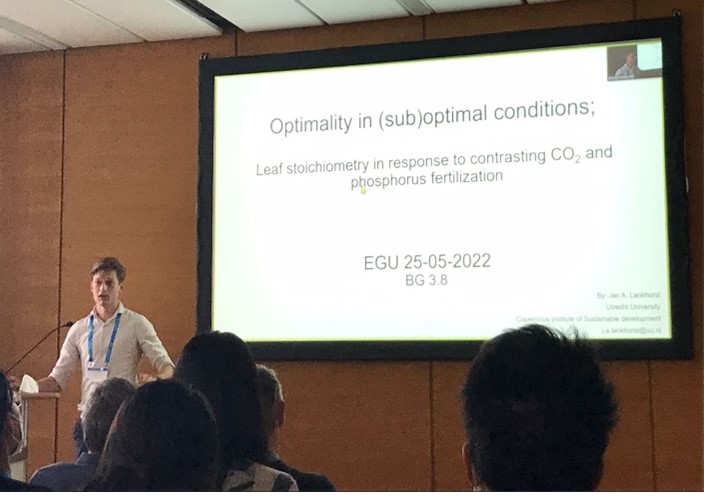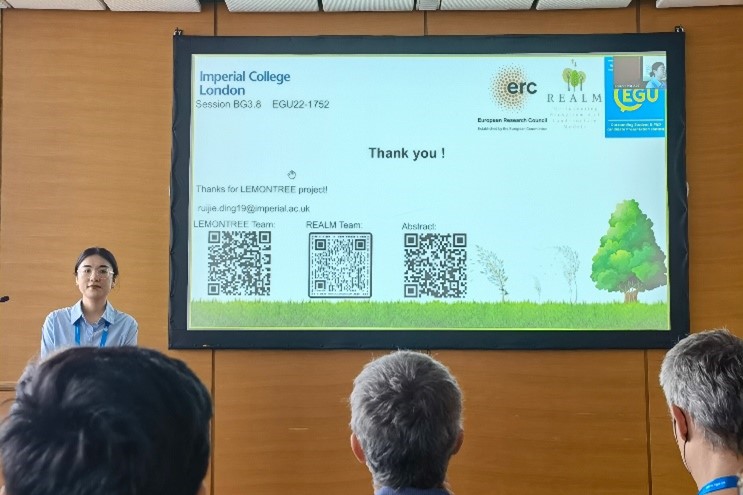Now that EGU (European Geosciences Union) General Assembly for 2022 has come to a close and everyone is back to work, it’s been good to reflect on the week and what a week it was. As with everything else, EGU was cancelled in 2020, then moved to being 100% virtual in 2021. This year was the first ever fully hybrid EGU and for many of the LEMONTREE team it was great to be there in person in Vienna along with the 7,315 other participants and a further 7,002 participants online. For some of our PI’s and post-docs, this was a much anticipated return to our main conference on the year, something that is, in normal times, an annual pilgrimage. For many of our PhD’s it was their first experience at such a large and diverse conference, and for some their first ever conference.

Thankfully though, no-one had to present to 7000 people, but rather to smaller groups in one of the 791 sessions that took place over the 5 days of the conference. Sandy Harrison convened session 3.8: Exploring the use of optimality approaches in vegetation and land-surface models. This session, focussed on the the Eco-Evolutionary Optimality (EEO) theory which underpins LEMONTREE research, so it was no surprise to have several representatives from the project team there to present their work.
Eco-evolutionary optimality (EEO) theory relies on the power of natural selection to eliminate uncompetitive trait combinations – thereby allowing plants to adjust to their environment through multiple mechanisms, on time scales ranging from days to millennia. The result of EEO is more predictable and general patterns in vegetation structure and composition. EEO theory allows process formulations to be developed that are novel, parameter-sparse and, most importantly, highly testable with field and experimental data. The aim is to be able to develop simpler, more robust, reliable and realistic next-generation Earth system models.
Despite the application of EEO principles in vegetation and land-surface models being a relatively new approach, it is already resulting in considerable improvements in our ability to simulate vegetation responses to changing climate and environmental conditions.
For example, hypotheses derived from EEO principles are proving helpful in developing parsimonious representations of leaf-level processes such as photosynthesis and primary production, dark respiration, and stomatal behaviour. EEO approaches can also be applied to at whole plant and community levels, providing simple ways of representing plant interactions and ecosystem dynamics. Comparisons of EEO-based predictions against experimental data and field and remote-sensing observations provide a way of evaluating the robustness of the hypotheses, as well as discriminating between alternative EEO hypotheses.
In this optimality session, the 19 presentations were diverse and informative, bringing together scientists applying the EEO theory to plant behaviour from cellular to global scales, focussing on plant traits such as leaf area index, stomata, transpiration and the conductive efficiency of the xylem. The role of nutrient availability and photosynthetic pathways were also discussed. Case studies ranged from China to alpine vegetation, from using paleodata to predicting future plant adaptions in our ever-changing climate. Showing the state-of-the-art in modelling, whether from experimental or observational data sets and thinking of ways to move EEO-based approaches forward as our knowledge grows. The session allowed discussions and idea sharing between eminent scientists at the forefront of this novel approach, to young scientists just starting out in their career.


PhD student, Jan Lankhorst (left). Talk title at EGU session 3.8 : Optimality in sub(optimal) conditions; leaf stoichiometry in response to contrasting CO2 and phosphorus fertilisation

Ruijie Ding (right). Talk title: Optimal trait theory: testing predictions on the Northeast China Transect presenting optimality research at EGU session 3.8.
Whilst there was a large LEMONTREE presence in the room, there were many scientists there from other projects who are also interested in optimality principles. However, given EEO is a relatively new approach for modelling, the theory is not always well understood or accepted. This session gave the team an opportunity to explain various intricacies of the theory and how it can be applied to the next generation of models. Although differing in perspectives and methods at times, it was a warm and friendly atmosphere with ideas shared and problems in the approach discussed and debated.

Whilst everyone will have come away from this session with their own take home message, we like this:


There are huge benefits to the new hybrid format for EGU, such as the ability to participate even you cannot attend in person and lower carbon emissions with few participants travelling to Vienna. Whilst it was by and large a success, there are downsides to not attending in person.


It is this lack of interaction outside of the sessions which is the main drawback to not attending in person. A lot of idea sharing happens over a casual coffee, collaborations are initiated and planned and colleagues, usually separated geographically can get together to network, reconnect and socialize. Just as the team did at a dinner hosted by Sandy for the LEMONTREE team. Over a nice meal and a glass of wine (OK, several!), the conversations and ideas flowed.
 Back row left to right: Remko Nijzink, Jan Lankhorst, Astrid Odé, Jaideep Joshi, Giulia Mengoli, Jaize Li, Ruijie Ding, Yunke Peng, Sandy Harrison, Colin Prentice
Back row left to right: Remko Nijzink, Jan Lankhorst, Astrid Odé, Jaideep Joshi, Giulia Mengoli, Jaize Li, Ruijie Ding, Yunke Peng, Sandy Harrison, Colin Prentice
Front row: left to right: Chuanxin Gu, Cai Wenjia (Shirley), Alienor Lavergne, Oskar Franklin, Karin Rebel, Ning Dong.
We look forward to where the next-generation of next-generation terrestrial modelers take us, working alongside Sandy and the other LEMONTREE PI’s, we hope that we can develop models that focus on optimality that are even more robust, reliable and realistic.
Table. 1. List of talks and their presenters in the Optimality session. Click here to read the abstracts and learn more about each presentation. Presenting scientist in italics.

